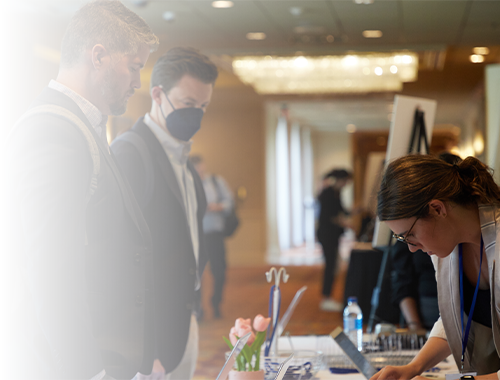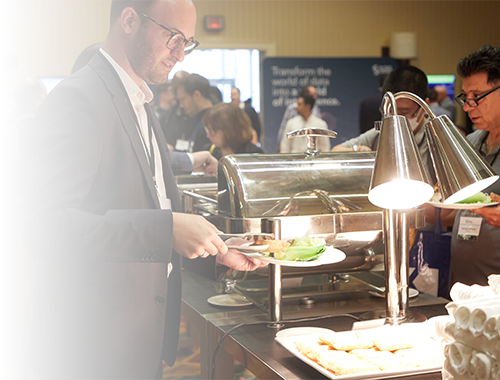
8:00 am
NETWORKING BREAKFAST:BUILD COMMUNITY CONTACTS
- Start your day off right and connect with food safety leaders.
- Get to know your industry peers and colleagues over a delicious breakfast.
- Source practical tips, discuss best practices, and prepare for the day ahead.

8:45 am
OPENING COMMENTS FROM YOUR HOST
Gain insight into today’s sessions so you can get the most out of your conference experience.
8:55 am
OPENING KEYNOTE
Getting the Latest on Enforcement Guidance from the CFIA
Stay abreast of how CFIA conducts it’s inspections and understand the difference between inspection and enforcement. Take away specific solutions to:
- Prepare for upcoming CFIA inspection processes
- Ensure your facilities are compliant
- Follow best practices according to the inspection agency
9:25 am
C-SUITE PANEL
Optimizing Food Safety through Industry Innovation
Adopting new technologies and developments is essential for improving process efficiency and accuracy in food safety. Source practical tips to: Implement the latest technological, automated, and biopharmaceutical approaches to food safety.
Harness available solutions to optimize your techniques and processes. Overcome innovation challenges, including budget and resource limitations.
Advance your expertise to integrate new techniques and technology across your food safety and QA processes.
9:55 am
SPEED NETWORKING!MAKE MEANINGFUL CONNECTIONS
Grow your network by meeting like-minded individuals to share your latest ideas and projects with:
- Enjoy a quick icebreaker, exchange LinkedIn information, and build lasting business relationships.
- Achieve your conference networking goals in a fun and agile fashion.
- Join a community of food safety leaders and gain invaluable support.


10:15 am
INDUSTRY EXPERT
EMP Data Maturity: Where Food Safety and Risk Management Meet
Food safety teams are constantly challenged to justify their investments in new technology – from the latest test methods and equipment to the introduction of advanced data analytics and supporting software and required skills. One of the barriers to effectively communicating this justification is the disconnect that often exists between a public safety-minded food safety team, versus the business risk-led decision-making priorities within the head office. Recount real-world examples to illustrate how data management, analytics
and workflow automation technologies are being applied to mitigate many forms of risk, and how to convince executives to buy-in to advancing these capabilities.
Attendees will take away new ideas and concepts that they can use right away:
- Understand how different stakeholders perceive and prioritize risk
- How to tie food safety risk to tangible business and economic outcomes
- How food safety leaders and business decision-makers can collaborate to support the advancement of improved risk management through data analytics
Gain a new perspective on how digitized food safety testing programs provide much-needed data justification for translating value to business outcomes.
10:45 am
INDUSTRY EXPERT
From Reactive to ProactiveUnderstanding Your Digital Maturity to Elevate Food Safety
Digital transformation is key to moving from reactive food safety measures to proactive, data-driven strategies. This session will explore how digital maturity models can help organizations assess their current capabilities, identify gaps, and develop a roadmap for advancing food safety practices.
- Evaluate where their company stands on the digital maturity scale
- Discover practical steps to leverage technology for stronger compliance, efficiency, and risk management
- Build a framework to drive the next level of food safety, whether you’re just beginning or optimizing existing systems
11:15 am
EXHIBITOR LOUNGE:VISIT BOOTHS & SOURCE EXPERTISE
- Explore the latest food safety technology and strategies with our industry leading sponsors.
- Share your challenges with the biggest innovators in the business.
- Schedule one-to-one private meetings for personalized advice.



11:45 am
CASE STUDY
Key Elements of Food Safety Procedures in Hospitality
Food safety in the hospitality industry relies on consistent training, audits, and process updates. Take back to your office strategies to:
- Prioritize hygiene, cross-contamination prevention, and temperature control to ensure food safety
- Stay informed about Canadian food regulations in the hospitality industry
- Understand the role of staff training in protecting consumers and safeguarding brand reputation
Optimize food safety standards through continuous improvement and training insights from the hospitality industry.
11:45 am
MASTERCLASS
Building Your Food Safety Culture
Building a strong food safety culture goes beyond compliance — it involves fostering shared values, attitudes, and behaviours that prioritize food safety at every level of your organization. Adopt best practices to:
- Explore the key components of food safety culture and learn how to build it within your organization
- Develop actionable strategies to strengthen food safety culture within your teams
- Align leadership, employee behaviour, and food safety practices to create a culture that enhances both safety and quality
Bolster your company’s food safety culture with practical, hands-on guidance to transform processes and ensure long-term success.
12:15 pm
CASE STUDY
Lessons Learnt from Food Safety Processes in the Pet Food Industry
12:15 pm
MASTERCLASS
Adopting New Technologies for Streamlined Safety Processes
12:45 pm
CASE STUDY
Harnessing tools and training for effective Food Safety Management in the Foodservice Industry
Delve into our overall strategy around data, technology in the area of food safety and how if fits into our broader business.
- Benefit from examples of things we’ve been testing (both at the restaurant, with suppliers and at a corporate level)
- Share our global training strategy and how we’re using technology to reach our global community and data to ensure we’re focused on right things
Identify key learnings and potential pitfalls
1:15 pm
NETWORKING LUNCH:DELVE INTO INDUSTRY CONVERSATIONS
- Meet interesting speakers and pick their brains on the latest industry issues.
- Expand your network and make connections that last beyond the conference.
- Enjoy great food and service while engaging with your food safety colleagues.


2:15 pm
PANEL
Measures to Mitigate Food Fraud Risk in the Canadian Market
What steps is the food industry taking to protect consumers and ensure a more secure and trustworthy supply system in Canada? Bolster your internal strategies to enhance food fraud detection, strengthen traceability systems, and ensure the safety and authenticity of your products. Take away specific solutions to:
- Deploy authentication methods for ingredients and food products at every stage of production
- Identify methods to recognize food fraud, including enhanced traceability systems, stricter regulatory enforcement, and industry-wide collaboration
- Protect your consumers and brand both nationally and internationally through robust food fraud detection processes
Reduce and prevent food fraud to ensure the safety and authenticity of your products.
2:45 pm
INDUSTRY EXPERT
Food Safe Automatic Bag Slitting and Sanitary Conveying Technologies
Equipment produced from FDA and USDA machine design standards with fast wash down features are advancing the sanitary standards of safe food handling and production.
Food industry specific, sanitary designs with clean-in-place capabilities achieve:
- Consistent, sanitary contact surfaces free of pathogens and allergens to deliver safer food production.
- Reduced contamination related waste.
- Improved ingredient handling and production line yield.
- Fast sanitary wash downs that reduce production sanitation downtime up to 90%.
3:15 pm
EXHIBITOR LOUNGE:ATTEND VENDOR DEMOS & CONSULT INDUSTRY EXPERTS
- Enjoy exclusive sponsor demos and experience the next level of food safety innovation firsthand.
- Meet one-on-one with leading solution providers to discuss organizational hurdles.
- Brainstorm solutions and gain new perspectives and ideas.



4:15 pm
CASE STUDY
Taking A Risk-based Approach to Precautionary Allergen Labelling – New Global Recommendations on the Horizon
New guidance is emerging from the recent work undertaken by the Codex Committee on Food Labelling (CCFL) which incorporates risk assessment and the use of allergen thresholds to improve the effectiveness and clarity of precautionary allergen labelling (PAL). The committee’s consideration of recommendations for adopting a risk-based approach, including allergen thresholds, mark a significant step toward a more standardized and consistent approach to PAL, offering benefits for both manufacturers and allergic consumers.
4:45 pm
PANEL
Developing Allergen Best Practice Across the Food Industry
Failure to manage allergens can lead to sever e health risks, product recalls, and damage to brand reputation. Source practical tips to:
- Harness the power of continuous staff training in proper allergen management across production, manufacturing, retail, and food service
- Learn from experts across the food supply chain
- Discuss the importance of traceability and supplier communication in mitigating allergen risks
Perfect your allergen management skills to reduce risk to your consumers.
5:15 pm
CLOSING COMMENTS FROM YOUR HOST
Review the key solutions and takeaways from today’s sessions. Source a summary of action points to implement in your work. Discuss tomorrow’s highlights!
5:25 pm
EVENING RECEPTION:ENJOY GREAT CONVERSATION, MUSIC & NETWORKING
- Relax and unwind with tasty cocktails after a long day of learning.
- Don’t miss your chance to win fun prizes at our Reception Gift Giveaway.
- Make dinner plans with your new connections and explore the best of what Toronto nightlife has to offer. Just be sure to set your alarm for Day 2!


5:30 pm














